
Sailing Vessel Beruta Ship's Log
Curacao - Aruba
Monday, October 14, 2024
I returned to Curacao on Saturday, September 28 after hiking 2,650 miles from Mexico to Canada through the states of California, Oregon and Washington on the famous Pacific Crest Trail. The mountain adventure took me 145 days, and it was an excellent exercise stretching the boat legs before continuing my second round the world voyage. Hopefully, later I would make a film similar to "Following The Shadow: Te Araroa Or Around New Zealand in 119 days". For now there is just a photo album on Google Photos.
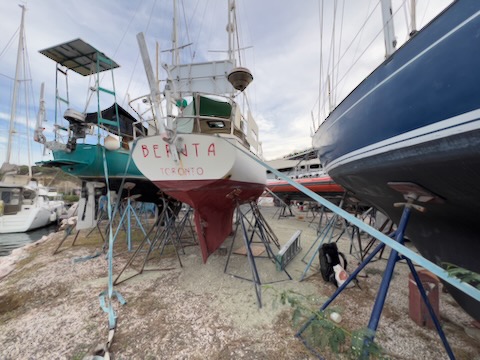
Beruta was safe in Curacao Marine hard storage. Even though I had asked the boatyard manager, Dirk (pronounced as Derek), to move the boat to the work area almost a month ago, they didn't do it! I had also asked them to open the plug in the bilge to drain it in case any rain water got collected inside the hull. They couldn't do it either - typical Caribbean attitude, even among the Dutch people! Oh, well, I had been paranoid about rain water because the rain season started in October and I couldn't remember whether I had cockpit lockers and the engine compartment open for ventilation or not. I also couldn't recall whether I left the bilge pump switch in auto or off position. It happened to be off but everything else was closed, so there was no water in the bilge anyway.
Later I found that the bilge pump electronic water detection switch actually failed to turn the pump on when it was submerged in water, so even if I did leave the switch in auto, it would not have worked! This was the second time when it failed. The first time I intended to replace it with a mechanical switch but after I removed it for testing, it miraculously began working again.
On Monday it took few hours for the marina to open me water, so I could sand, clean and wash the hull before antifouling. Because it was not the work area, the boatyard was full, water and electricity was very far. Luckily the marina provided a very long hose. As for the power, I had to rely on my solar panels and do wet sanding by hand. I also had to cut approximately 10 mm stainless anode holder rode on the prop shaft using a hand jigsaw. I wasted about 10 jigsaw blades for the job.
The reason I needed to do that was that it didn't hold the zinc anode well. The one that I had installed in New Zealand was lost at some point on the way to Curacao. This welded extension to the prop shaft was interfering with a different type of the anode holder that I intended to install. The new holder was basically a special nut that replaced the original nut that held the prop. The anode was then secured to the nut with a bolt.
The other problem was to find soft antifouling on the island. Most of them were hard. Altex No 5 paint that I used in New Zealand was soft. The marina was selling semihard paint from Seajet, 039. I had to apply a coat of Seajet primer 015. I used three 2.5 liter cans for priming and four one gallon cans for antifouling. There were only two colors available: black or blue. I chose blue. I would have preferred something brighter like red that I had before. Somehow I think that it is easier to spot by whales.
It was super hot in the marina. The first and second week there was no wind anywhere, probably because of three hurricanes in the Atlantic. Then the trade winds returned, but the marina was sheltered from them. For this reason mosquitos was another nightmare. I didn't know if I had survived this if not the little 12 v fan that I recently bought. It was around 40° C in the cabin during the day and 34-36° C at night.
The second week was short because of some national holiday. The marina was closed on Thursday and Friday, and they couldn't launch Beruta on Wednesday. So everything was slow.
Besides antifouling and the new anode, I also did some maintenance on Yanmar - replaced fuel and oil filters, replaced engine oil, cleaned exhaust manifold.
On Thursday my waterproof iPhone 13 Pro screen died. I took a shower and put long pants on without using a towel, so the pockets became wet. This amount of water was enough to get into the waterproof iPhone! I couldn't believe it! If I knew about this, the screen could have been saved! First, I spotted horizontal white lines across the screen in Safari. Hm... Just in Safari, not in other apps! Stupidly, I thought that some browser tabs might be creating this. Then they appeared in other apps or with no apps running at all. I even removed two new apps that I installed just before the lines appear. It ended rapidly with a white screen right after I installed the latest iOS updates.
When I googled the problem, the white screen happened to be a known case for iPhone 13 Pro and Max. Some people apply high voltage from a lighter to some pin on the screen to cure it. Other people solder a jumper between two pins. Well, I didn't have any tools to open the phone, so I brought it to the repair shop on Friday. It cost me $380 to replace the screen, and a technician revealed the reason for its failure.
The good thing about marina was a shuttle that went to the supermarket every day except Sunday. My initial plan was to sail to Panama, and I decided to stock up on Curacao for the 38-day sailing to Hawaii. Later I realized that crossing Pacific Ocean in November was still early. The hurricane season in the northern hemisphere ends at the end of November. The safer option is to leave Panama some time in December.
Waiting for over a month in Panama would not be ideal. I would need to buy an expensive cruising license there. Spending time in Colombia or Costa Rica would be interesting but clearing in and out of these countries are not cheap and very bureaucratic, especially in Costa Rica. I didn't want to stay in Spanish Waters because it's too dirty. Even a freshly antifouled hull could have marine growth in a week or two. After two months of anchoring in Spanish Waters, Beruta with antifouling applied 9 months ago, was completely covered with it.
Therefore, I decided to sail to Aruba and spend a couple of weeks there. Then I would contact an agent in Colombia to find the price for staying in Cartagena for one week. If it's acceptable, then visit it, and continue to San Blas before going to Colon.
Both Aruba and Curacao use SailClear.com for clearing in and out. The website started to charge $25 per year for their service. And Aruba introduced so-called sustainability charge of $20. So even Aruba is no longer free for visiting, although much cheaper than some other countries.
The launch was scheduled afternoon. Despite using SailClear.com for customs and completing online immigration cards, it was still needed to visit both Immigration and Customs. In the morning I cycled to Punda and Otrobanda for clearance. Customs had a new temporary office behind the Maritime museum after the fire in the main one. The Immigration office was still in the same building on the other side of the strait.
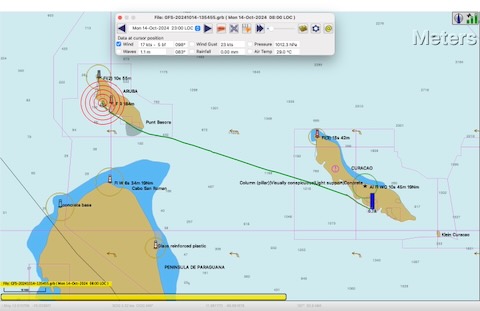
Beruta was launched between 4 and 5 pm.
When it was on a trailer, I antifouled two spots on the keel, which had not been accessible before because of support blocks. The ladder was already removed, so I couldn't leave a bucket with a screwdriver and a sanding pad aboard. Instead, I left them on a pier to take them to the boat later. I went to the office to pay the bill. I then had to turn Beruta around at the pier. There was very little room to do it under the engine. Being so occupied by this maneuver, I completely forgot about the bucket.
I left the marina at 5. I called Fort Nassau on VHF channel 12 to inform them of my movement in Schottegat harbor and to ask them to open the Queen Ema pontoon bridge.
The forecast was 18-23 kt easterly wind. I raised just main with three reefs knowing that the numbers in this waters were typically less than in reality. But it was very close to reality. While I was in a shadow of Curacao, the wind was 15-20 kts T and once I cleared the island, it became 20-25 kts T. Therefore, even with three reefs, Beruta was sailing around 5 kts. Windpilot did not work very well in 10 kt apparent wind. I used autopilot, which handled 20 kt apparent wind well with such a small sail.
Tuesday, October 15, 2024
The night was light with almost full moon despite some clouds, and busy with cargo traffic in the opposite direction. Once I had to change the course - it was head on collision. I was on watch and saw the ship before the AIS informed me about it. We both took to the starboard. It was easy for me since I was on the left tack. I didn't have to gybe.
Despite the traffic, I tried to have a nap. I dreamed about my first visit to Aruba, when the anchor didn't hold, the wind was so strong that I couldn't get to the shore on my little dinghy without an outboard, and I almost ruined Beruta on the way back tacking against 30 kt wind, waves and current. These were not pleasant memories. And then I thought where was the bucket? "Oh, no! I've forgotten it in Curacao! Should I go back?"
At the sunrise, I was near Aruba. The batteries were low, so I tried to start the engine, and it barely did that. Because of a huge voltage drop, everything got rebooted: all the electronics including the Raspberry Pis where my navigation software ran. They did not fully come back because of wrong time. I needed to look why the ntpd, the time service configured to use gps, was not setting the time as it should have. Possibly, because it takes some time for GPS to get it. In other words, there should have been some delay in starting the navigation software. Somehow the depth sounder came back with the default settings, showing the depth in feet without a configured offset. Strange. It did come back normally after I powered it up again in Barcadera though.
The wind shifted a bit, and I was sailing almost dead downwind. Autopilot could not handle it. It accidentally gybed at least three times, and it was deviating to the wind more than needed to reach Aruba on the same tack. As I was close to Barcadera, the only port of entry, I didn't want to fiddle with the windpilot and hence, I steered manually for the next hour or so.
When I got to the island, I decided to free my hands and let the autopilot do the job. It was so upset by my lack of trust in it in the first case that it decided to quit in its usual manner: the push-pull rod got disconnected from the drive! Thank you Raymarine for the awesome foolproof design! I steered manually again, then gave up and brought the spare autopilot.
Venezuelan sailors helped me with the docking lines in Barcadera.
Both Customs and Immigration are onsite. It didn't take much time to complete the formalities with them. Immigration didn't even check my online visitor's card or whether I paid the sustainability fee. Perhaps, they'd already known it.
The Customs acknowledged that I used SailClear.com. It seemed that it was still optional. The officer briefly looked inside my engine compartment, and this was the end of the boat inspection. He took my speargun and Hawaiian sling though, promising to return them when I leave the island.
I sailed further down to Oranjestad anchorage. I read about a possibility to go there via Bucuti channel, and even put the waypoints in OpenCPN. By attempting to do so, I would have put all my trust into a person who I do not know. The channel is a grey area in all my charts. On the other hand, there is Varadero marina there, so there must be a way to get in and out of it safely. Anyway, since it was still downwind, I sailed on the outside of the reef.
This time there were about 10 boats, mostly cats, on the anchorage in front of the airport. There seemed to have been many more boats in or around Varadero.
I dropped the anchor in about 3 m of water and went for a swim to check the anchor.
I knew that holding in this anchorage was bad from my first visit, when I had to deploy two anchors after one anchor didn't hold.
The bottom was grass over sand over mud over rocks. All layers except the last one were thin. And the anchor was dragging. I used a knife to dig a hole. While I was doing this, I was surprised by a huge manta coming to check me! This was the first time I'd seen mantas in Caribbean Sea. The only time I saw them before was in Bali in cold water. Sea turtles were also nearby, but they were not so surprising. The dug hole seemed to have stopped dragging. I watched it for a few minutes, then went aboard to do something that I had forgotten to do before the departure.
The boat was taking water. After the launch, I noticed some fresh water coming to the bilge from the water tank. Hm... Strange. This could have been from... where? From the vent?? Could the plastic tank develop a crack somewhere?? There was also water around the rudder shaft. I forgot to tighten the stuffing box nut. It might have needed another round of PTFE shaft packing. Indeed, I managed to insert one more. This stopped the salt water from getting inside the boat from the rudder shaft. Some salt water could still enter the boat from the engine PSS shaft seal.
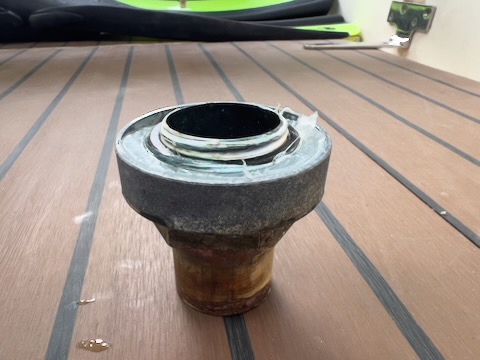
While I was writing this on Wednesday, October 16, I decided to investigate. There was still water in the bilge and there was water under the water tank - fresh water. So the tank was leaking somewhere. The obvious outlet fitting had no problem. To check the intake fitting, I needed to completely empty the entire fore cabin. There it was. Water was dripping through the bronze fitting where the intake hose was attached. It appeared to have been a sort of nut. So I decided to tighten it, and... I made it worth. It started to leak a lot, so I had to drain more than half of the full water tank. This time I decided to remove the fitting unscrewing the nut and it fell off. Apparently, it was not even threaded, it was just glued with a silicon adhesive.
I wondered why someone had done that. Perhaps, the thread was not tight enough but why not to use some sealant like Sikaflex? Someone appeared to have used a Teflon tape, and even that was not enough?
Well, I thought to try using Sikaflex but my tube had already been open, and it all cured. So I would have needed to go ashore and buy a new one. Ok, another day then.
Anyway, after checking the anchor and tightening the nut on the rudder shaft, I cooked my lunch: potatoes with some canned fish. I just sat to eat it, when I noticed that Beruta was moving downwind fast. The anchor did not hold. The anchor alarm started to beep a few seconds later. Damn it!
I anchored in a way that if the anchor did not hold, there would have been no boats behind me. At least, this time I didn't have to worry about a collision with them. It was also quite deep downwind, so no worries about being grounded. I just needed to pull all 30 meters of the chain against 25 kt wind. This was difficult, especially as I did it with bare hands. It was not enough time to search for gloves. Well, at least the chain was more or less clean, no sharp barnacles have grown on it yet.
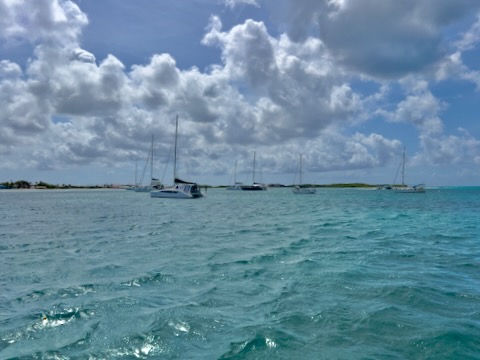
The second attempt to drop the anchor was closer to the shore and even in a shallower water, around 2 meters. There was deeper sand. The anchor seemed to have held on its own, but I decided to dig a better hole for it using just the knife. It took some time. Then I placed the anchor in this hole, and it appeared to have been secured. At least, there was no dragging till the end of the day and no dragging next day.
I even modified my software to display the anchor dragging on a Raspberry Pi LCD along with other data such as weather, time, etc.
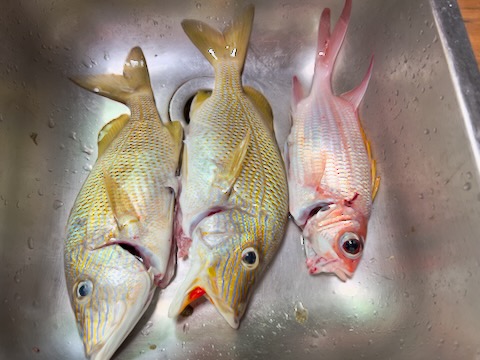
Thursday, 17 October 2024
After finishing my morning yoga, and having breakfast, I snorkeled to check the anchor again before going to the shore. It did not move, but I had not much confidence that it wouldn't. I dug a new deeper and bigger hole using a knife and a wide scraper as a spade. Once I put the anchor in it, I used a mini sledgehammer to drive the anchor even more into sand. I then reversed with the engine to check that it held fine.
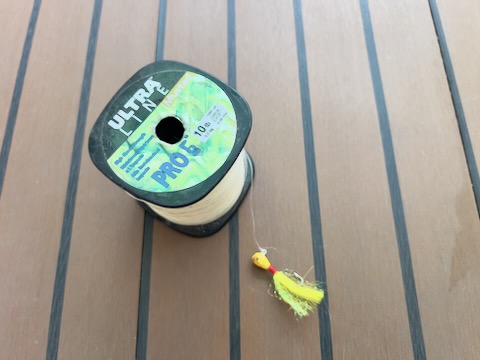
And then it was lunchtime. Instead of going ashore, I fished and caught two white grunts and one squirrel fish in just few minutes using a small hook with yellow hairs as a bait. It took much longer to clean them, fry, and then do the dishes. The day was almost over. Nevertheless, I launched the dinghy, and went to a nearby bar at the beach, hoping to use the Internet there. Two small beers cost me $18! Crazy! I had also hoped to connect to the bar's Wi-Fi from aboard using my Bullet-2 Wi-Fi router with a good antenna, but it was too far. It made little sense to pay this price for a few minutes of Wi-Fi. I should have gotten a local SIM card instead.
All pictures from Aruba are on Google Photos.

